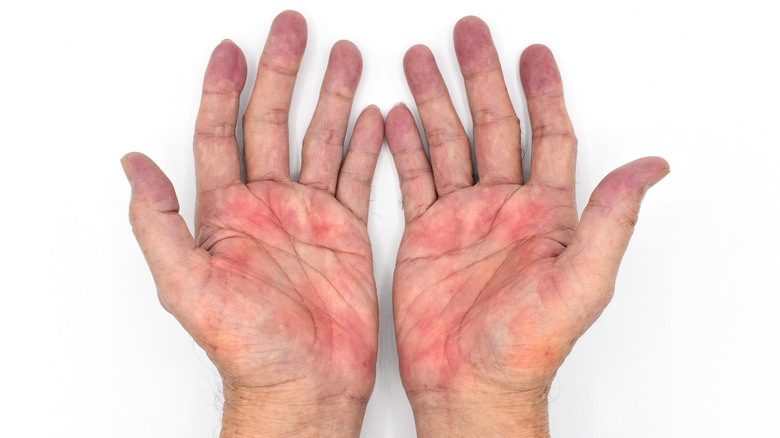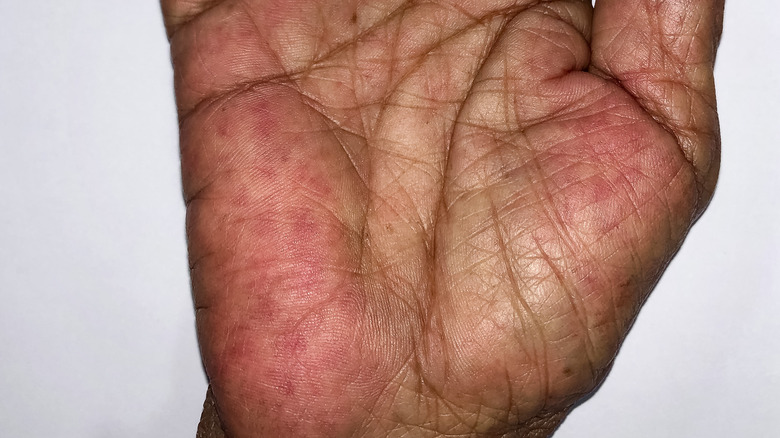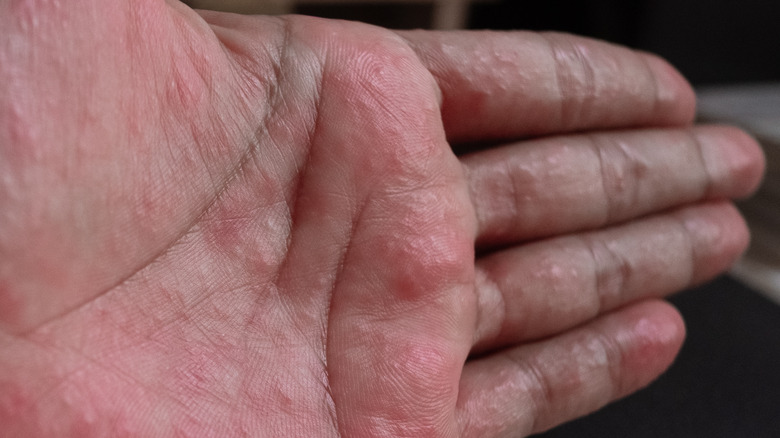What It Really Means When Your Palms Turn Red
Redness of the palms may seem a little strange but if it comes with no other symptoms, like pain or itching, you might not think twice about it. You should, however, because it can be an indicator of much more serious health conditions.
This condition is known as palmar erythema and is caused by dilated capillaries, according to WebMD. It can happen for benign reason like hormonal changes during pregnancy, and it can also exist for no known reason. It's generally symmetrical, with both palms turning red, and they may feel a bit warm. However, they should not hurt or itch.
The redness generally covers the lower half of the palm but can rise into the fingers and even the nail beds. It should turn white if you press on it, then return to red. Palmar erythema can be hereditary, so a person with someone in their family with the condition is more likely to develop it themselves.
It can indicate another concern
Palmar erythema is sometimes a secondary symptom of another disease. It is sometimes called "liver palms" because it can be linked to disorders of the liver, such as cirrhosis, according to Healthline. Other liver diseases like Wilson's disease and hemochromatosis may also cause palmar erythema.
Autoimmune disorders, including rheumatoid arthritis, have been found to cause red palms, along with diabetes, hepatitis C, eczema, brain cancer, thyroid disorders, infections, and chronic obstructive lung disease (via Medical News Today). If you develop red palms, your doctor will likely test you for one or more of these conditions, depending on what other symptoms you might be experiencing.
Some medications can also cause palmar erythema. For people with normal liver function, topiramate or albuterol might produce red palms, per Healthline. For those with diminished liver function, amiodarone, cholestyramine, or gemfibrozil might create the response. If you develop red palms, contact your doctor to discuss it and see if testing is required to rule out any underlying conditions.
Environmental factors can contribute
Palmar erythema can be caused by a multitude of factors within your body (per Healthline). However, sometimes the cause of palmar erythema doesn't come from within your body, but from the environment around you. Palmar erythema can form after the skin on your hands comes into contact with an irritant. If you're already experiencing palmar erythema, the condition can be exacerbated by pressure placed on your hands, holding your hands and arms up, various temperatures, and even by your emotions.
There are also lifestyle activities that can lead to palmar erythema. WebMD reports that excessive alcohol consumption, smoking, and too much mercury can lead to palmar erythema. An estimated 23% of people with cirrhosis of the liver, when the liver is severely damaged by scar tissue as a result of liver disease, also suffer from palmar erythema.
Even certain products that you put on your skin can increase your risk. A 2021 study published in the Journal of Tropical Pediatrics found that excessive use of hand sanitizer in children, especially hand sanitizer with artificial coloring, caused fluctuating palmar erythema alongside atopic dermatitis and eczema.
How palmar erythema is diagnosed
The manner in which palmar erythema is diagnosed depends on which type you may have (per WebMD). If you are pregnant and experiencing palmar erythema for the first time, your doctor may assess for pregnancy-induced palmar erythema. If you have a family history of palmar erythema and therefore a genetic predisposition for the condition, that will be a starting point for diagnosing it.
According to WebMD, your doctor will also want to know if it's primary (hereditary or caused by pregnancy) or secondary (caused by another health condition). When you visit your doctor with concerns about red, warm, or blanched palms, your provider will likely go over your medical history to determine the cause. It's important to rule out conditions that could become serious.
When you visit your healthcare provider for an exam, you may undergo assessments of your liver function, iron levels, fasting glucose levels, hormones that stimulate your thyroid, and tests for Hepatitis C and Hepatitis B. In the process of diagnosing palmar erythema, you may undergo testing for liver disease, diabetes, HIV, thyroid disease, brain tumors, and autoimmune diseases. Since the diagnostic process of determining the cause of palmar erythema is so varied, it'll be up to your doctor's discretion as to which diagnostic tests will be suggested.
Treatments for palmar erythema
If palmar erythema is deemed secondary, the underlying condition will need to be addressed, says MedicalNewsToday. At times, palmar erythema is left alone because the underlying cause is temporary, such as during pregnancy. If it's suspected that palmar erythema is a side effect of a medication, then alternative medications or dosage adjustments may be made, but never stop or adjust a medication dose without your doctor's advice.
WebMD reports that because palmar erythema is usually a side effect of another condition, it's paramount to be aware of other symptoms you are experiencing. Since some of the underlying conditions that cause palmar erythema can be serious, it's important to discuss additional symptoms with your healthcare provider so that treatment options can be promptly implemented.
Two common underlying conditions of secondary palmar erythema are hemochromatosis and cirrhosis of the liver, per MedicalNewsToday. If palmar erythema is caused by hemochromatosis, a condition in which the body has a buildup of iron, other symptoms may include fatigue, joint pain, difficulty concentrating, and unexplained weight loss (per WebMD). Treatment for hemochromatosis may include regular visits to your doctor's office for blood withdrawals. Cirrhosis of the liver often causes palmar erythema, and early symptoms may include nausea, fever, weight loss, fatigue, and loss of appetite (via Cleveland Clinic). Treatments for cirrhosis depend on the stage of the diagnosis and typically involve lifestyle changes and management of the condition.





